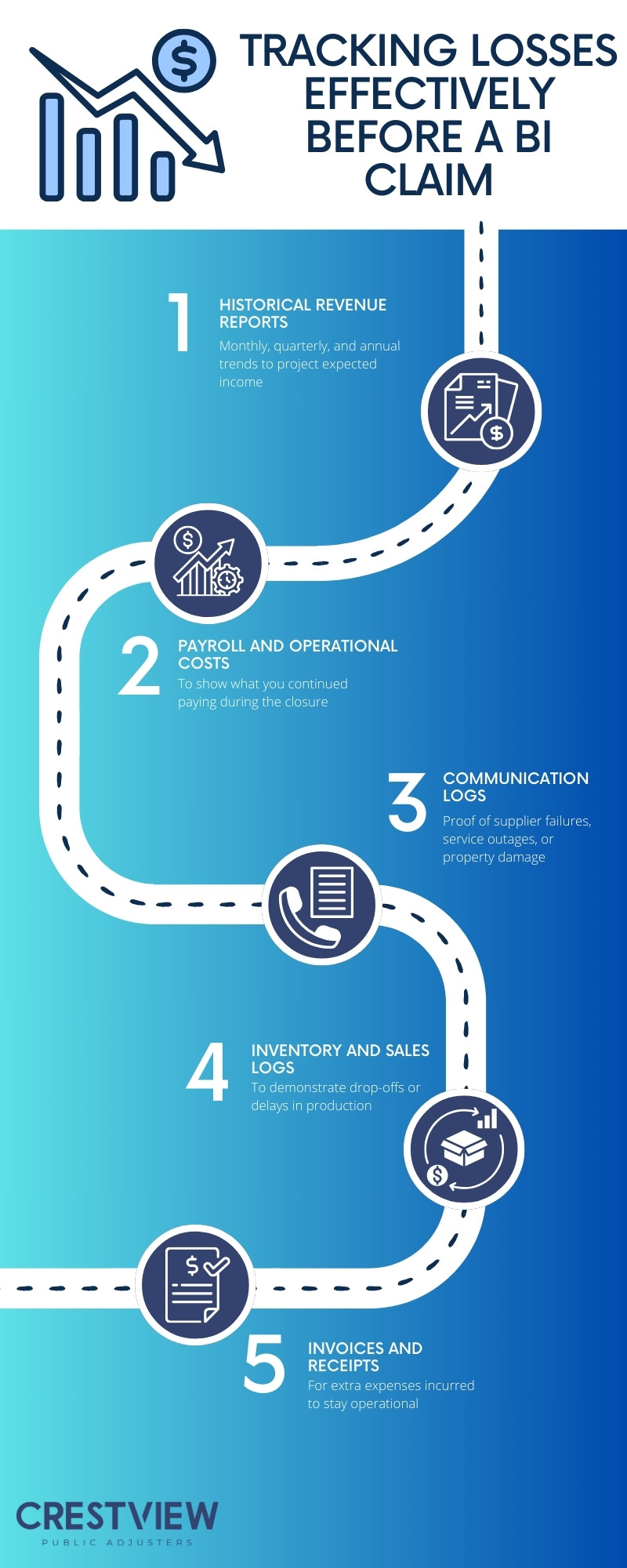Key Points:
- Many businesses remain underinsured or unaware of the limits in their business interruption policies until a major crisis hits.
- Understanding the triggers, exclusions, and payout structure of business interruption insurance is crucial for fast recovery.
- Working with a public adjuster early can significantly improve your claim preparation, policy understanding, and coverage strategy.
Public adjuster tips for better business interruption coverage include understanding what events your policy actually covers, verifying your coverage limits against your current revenue, and documenting losses with precision. These steps reduce disputes and ensure faster claim payouts when you need them most.
The Real Cost of Downtime—and Why You Need Better Coverage
According to a 2023 report from the National Federation of Independent Business (NFIB), nearly 40% of small businesses never reopen after a major disaster. And yet, business interruption (BI) coverage remains one of the most misunderstood parts of commercial insurance.
Business interruption insurance is designed to replace lost income when operations are halted due to a covered peril. But the truth is, many policyholders don’t know what “covered peril” really means in their contract—or whether their coverage is sufficient. Even more troubling, many don’t realize their policy has sub-limits, waiting periods, or exclusions that drastically limit payouts.
That’s where public adjuster guidance becomes essential. Understanding your policy language, and preparing for claim situations in advance, isn’t just smart—it could be the difference between reopening your doors and shutting down for good.
How Can a Public Adjuster Help You Plan Ahead?
Before disaster strikes, a licensed public adjuster can review your business interruption insurance and identify coverage gaps that could expose your business to unnecessary risk. This is especially important for industries with complex revenue cycles or supply chain dependencies.
Here’s how public adjusters offer long-term value:
- Policy Reviews with Business Context: They match coverage against real revenue structures—not just generic templates.
- Claims Experience Insight: They’ve seen where insurers deny or reduce claims and can flag those weaknesses in your current policy.
- Customized Documentation Guidance: They help you build loss-tracking systems that align with insurer expectations, cutting delays in the claims process.
Planning ahead with the right expert prevents mistakes, clarifies expectations, and sets you up for a smoother recovery when business is interrupted.
What Should Business Interruption Insurance Actually Cover?
If your building burns down, you expect your insurer to cover the income you lost while rebuilding. But many forget that BI insurance also needs to cover:
- Temporary relocation and operations at another site
- Lost income due to supply chain disruptions
- Revenue loss from dependent properties (like vendors or partners)
- Payroll for key employees
- Extra expenses to minimize interruption
However, policies vary significantly. A public adjuster will review the fine print with you to ensure that your business interruption insurance truly fits your risk profile.
Common gaps that catch businesses off guard:
- Waiting periods (often 72 hours before coverage begins)
- Sub-limits for specific causes (like flood or cyber incidents)
- Exclusions for government-ordered closures or indirect losses
Policies that fall short in these areas may result in payouts that don’t come close to covering your real losses. That’s why reviewing coverage proactively is crucial.

How to Evaluate and Upgrade Your Business Interruption Policy
You can’t manage what you don’t measure. If you haven’t analyzed your BI policy in over a year, now’s the time.
Here’s how to do it right:
- Estimate Your Actual Revenue Loss Potential – Use monthly financials to assess average gross profits. Project potential downtime across scenarios—fire, equipment failure, cyberattacks, etc.—and calculate the real cost of closures.
- Identify Dependencies in Your Operations – What happens if your top supplier goes offline? Or if your power provider has an extended outage? Many BI policies ignore these external dependencies unless explicitly listed.
- Confirm What Triggers Coverage – Policies only pay if the loss is caused by a “covered peril.” That term needs clear interpretation. A public adjuster will break down whether those perils match your most likely risks.
- Align the Coverage Term with Your Recovery Timeline – Rebuilding a manufacturing facility might take a year—but your BI coverage may only extend for 6 months. Understand the policy’s “period of restoration” and adjust accordingly.
- Consider Adding Contingent BI or Extra Expense Coverage – These riders can save your business if third-party interruptions prevent you from operating—or if you need to spend extra to continue working during repairs.
What Triggers the Most Business Interruption Disputes?
Understanding what causes most BI claim denials helps you avoid repeating others’ mistakes. Insurers tend to dispute claims based on:
- Lack of documentation for income projections and loss timelines
- Ambiguity in the policy language (what counts as “physical damage”?)
- Inadequate preparation before the loss occurred
- Exclusions buried in fine print
The good news? A public adjuster doesn’t just step in after a loss. They help you plan and structure your financials in advance to make your future claim much stronger.
Top claim dispute triggers:
- Income loss estimation not aligned with policy definitions
- Failure to track expenses incurred to reduce loss
- Coverage gaps from misinterpreted exclusions
- Delayed filing and unclear documentation
- Overlooking contingent or cyber-related triggers
Why Cyber Events Now Belong in Your BI Planning
More businesses now rely on cloud systems, SaaS platforms, and digital payment processors. So when a cyberattack shuts you down—even for a day—it’s a real business interruption.
Yet most business interruption policies don’t automatically include cyber coverage.
That’s where riders and endorsements come in. For example, cyber business interruption coverage could apply when:
- A ransomware attack locks you out of your system
- A DDoS attack takes your site down, stopping transactions
- Your POS system gets breached and operations halt for an investigation
Your standard policy likely won’t pay for these unless you’ve added the right language. A public adjuster helps ensure this protection is in place and aligns with your operational model.
How Do You Track Losses Before Filing a BI Claim?
Filing a strong BI claim depends on how well you track your losses—not just what you lost, but how you prove it.
A public adjuster will help you build documentation protocols before a crisis so that when one occurs, you’re not scrambling.
Here’s what you should have in place:

Preparing this in advance puts you ahead. Public adjusters often create “claim readiness kits” tailored to your business model.
What Are the Long-Term Benefits of Working With a Public Adjuster?
Public adjusters aren’t just for emergency claims—they play a crucial role in shaping your overall risk management strategy well before a crisis hits. By helping prevent underinsurance, they ensure your policy accurately reflects your current operations and risks. Their expertise in documentation accelerates the claims process, allowing for a faster recovery time. They also strengthen your negotiation position by leveling the playing field with the insurer’s adjusters. With their help, policy language becomes clearer, so you fully understand your contract before it’s too late. And when disaster does strike, they focus on post-crisis business continuity, guiding your recovery plan toward a full comeback rather than mere short-term survival. These aren’t just convenient benefits—they’re strategic advantages that safeguard your business and livelihood when it matters most.
Secure Better Business Interruption Protection Today
A crisis hits, and time is money. The difference between a fast recovery and a drawn-out closure often comes down to how well your policy fits—and how prepared you are to file. Use these public adjuster tips for better business interruption coverage to avoid common mistakes, plug policy gaps, and safeguard your operations.
Partner with Crestview Public Adjusters
Protect your future with expert help before disaster strikes. Crestview Public Adjusters specializes in helping businesses navigate complex claims—including Cyber Insurance Claims—with tailored insights that optimize your business interruption strategy.
Whether you’re in New York, Florida, or New Jersey, Crestview’s experienced public adjusters will walk you through the entire claims process, advocate on your behalf, and ensure you recover what you’re owed. Contact Crestview Public Adjusters today to strengthen your business interruption coverage before the next crisis hits.

